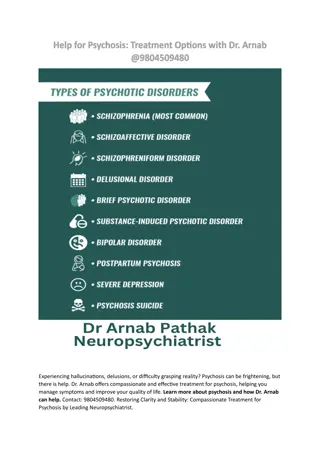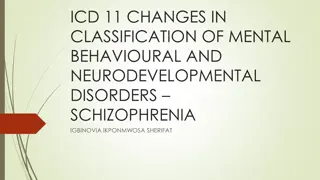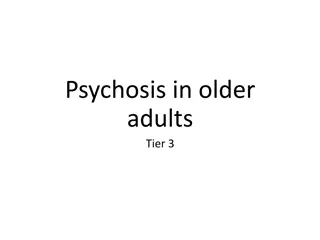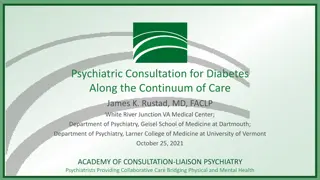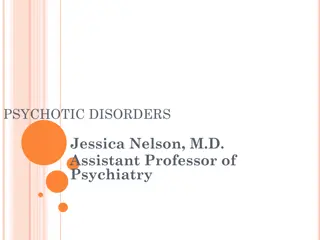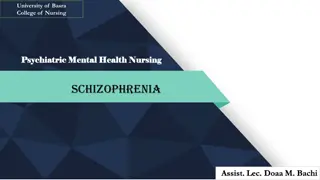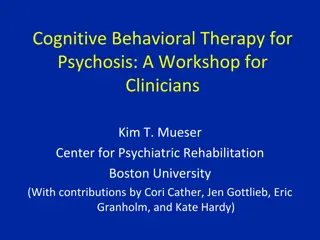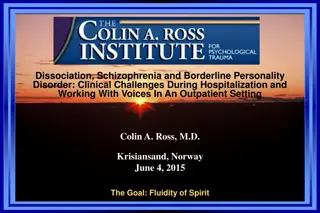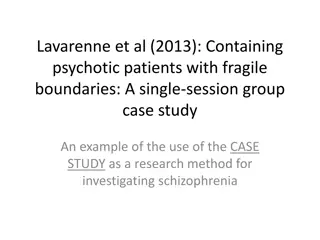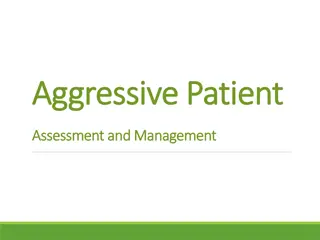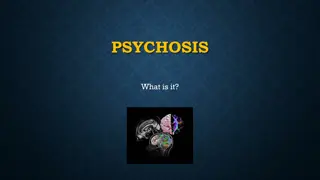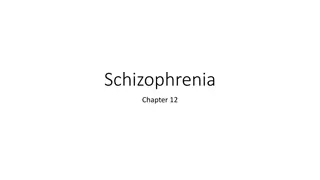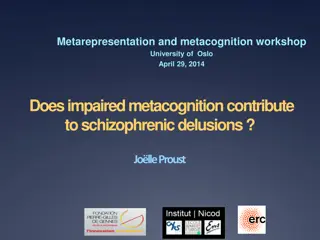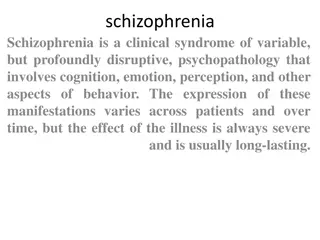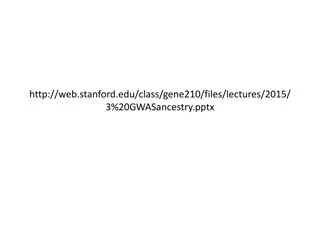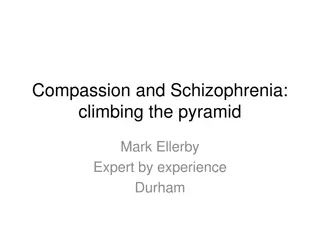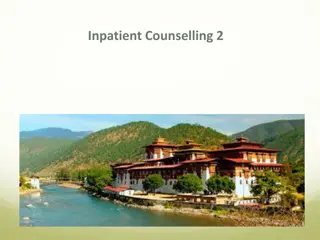Understanding Schizophrenia and Psychosis: A Comprehensive Overview
Schizophrenia and psychosis are mental health disorders characterized by distortions of thinking, perception, and inappropriate emotions. While psychosis is a symptom, schizophrenia is a specific diagnosis that includes symptoms like hallucinations, delusions, and cognitive deficits. Learn about the history, symptoms, and diagnostic criteria of these disorders.
Download Presentation

Please find below an Image/Link to download the presentation.
The content on the website is provided AS IS for your information and personal use only. It may not be sold, licensed, or shared on other websites without obtaining consent from the author. Download presentation by click this link. If you encounter any issues during the download, it is possible that the publisher has removed the file from their server.
E N D
Presentation Transcript
Schizophrenia and other psychotic disorders
Psychosis, schizophrenia What does psychosis mean? What does schizophrenia mean? Is there any difference between them?
Psychosis, schizophrenia Psychosis: - symptom, not illness - halucinations, delusions, thought disorder Schizophrenia: - one of the psychoses, diagnosis
Definition of SCH The schizophrenic disorders are characterized in general by fundamental and characteristic distortions of thinking and perception, and affects that are inappropriate or blunted. Clear consciousness and intellectual capacity are usually maintained although certain cognitive deficits may evolve in the course of time. The most important psychopathological phenomena include thought echo thought insertion or withdrawal thought broadcasting delusional perception and delusions of control influence or passivity hallucinatory voices commenting or discussing the patient in the third person thought disorders and negative symptoms.
History Emil Kraepelin: This illness develops relatively early in life, and its course is likely deteriorating and chronic; deterioration reminded dementia ( Dementia praecox ), but was not followed by any organic changes of the brain, detectable at that time. Eugen Bleuler: He renamed Kraepelin s dementia praecox as schizophrenia (1911); he recognized the cognitive impairment in this illness, which he named as a splitting of mind. Kurt Schneider: He emphasized the role of psychotic symptoms, as hallucinations, delusions and gave them the privilege of the first rank symptoms even in the concept of the diagnosis of schizophrenia.
4 A (Bleuler) four A Bleuler maintained, that for the diagnosis of schizophrenia are most important the following four fundamental symptoms: affective blunting disturbance of association (fragmented thinking) autism ambivalence (fragmented emotional response) Bleuler thought, that they are primary for this diagnosis. The other known symptoms, hallucinations, delusions, which are appearing in schizophrenia very often also, he used to call as a secondary symptoms , because they could be seen in any other psychotic disease, which are caused by quite different factors from intoxication to infection or other disease entities.
Symptoms Positive plus , an excess or distortion or normal function Negative minus , lost functions Cognitive (Affective)
Positive symptoms Halucinations Delusions Formal thought disorder Bizarre behaviour
Halucinations What types of halucinations do you know? Which are typical for SCH? Can you imagine hearing voices ?
Halucinations Disturbance of perception Auditory: hearing voices , usual more, words or sentences, usually unplesant commenting, imperative, giving advice Intrapsychical: hearing own thoughts, thought broadcasting, thought insert, externalization, control Tactile, olfactory not so typical Visual not typical (delirium)
Delusions Disturbance of thinking/thought Delusion - a mistaken belief that is held with strong conviction 3 types: Macromanic immortality, grandeur, inventory, erotomania, Micromanic- nihilistic, autoaccusative, hypochondric, Paranoid paranoid, persecutory, control, jealousy, dysmorfofobic,
Formal thought disorder Disorganized thinking (and speech, and behaviour) Organized (logical) tangencial - disorganized
Negative symptoms Alogie relative absence of thoughts and speech Affective flattening little expressed emotion Avoliation apathy lack of initiation and persistence Anhedonia asociality lack of pleasure feeling Attentional impairment
Cognitive symptoms Impaired memory and attention Difficulty thinking through complicated processes, making sense of information Impaired ability to organize Poor decision-making Difficulty in interpreting social cues
Other symptoms Sleep distorsion Paralogia Catatonia Ambivalency (having simultaneous conflicting reactions, beliefs, or feelings towards some object) Anosognosia
The Criteria of Diagnosis (ICD-10) For the diagnosis of schizophrenia is necessary presence of one very clear symptom - from point a) to d) or the presence of the symptoms from at least two groups - from point e) to h) for one month or more: a) the hearing of own thoughts, the feelings of thought withdrawal, thought insertion, or thought broadcasting b) the delusions of control, outside manipulation and influence, or the feelings of passivity, which are connected with the movements of the body or extremities, specific thoughts, acting or feelings, delusional perception c) hallucinated voices, which are commenting permanently the behavior of the patient or they talk about him between themselves, or the other types of hallucinatory voices, coming from different parts of body d) permanent delusions of different kind, which are inappropriate and unacceptable in given culture
The Criteria of Diagnosis e) the lasting hallucination of every form f) blocks or intrusion of thoughts into the flow of thinking and resulting incoherence and irrelevance of speach, or neologisms g) catatonic behavior h) the negative symptoms , for instance the expressed apathy, poor speech, blunting and inappropriatness of emotional reactions i) expressed and conspicuous qualitative changes in patient s behavior, the loss of interests, hobbies, aimlesness, inactivity, the loss of relations to others and social withdrawal Diagnosis of acute schizophorm disorder (F23.2) if the conditions for diagnosis of schizophrenia are fulfilled, but lasting less than one month Diagnosis of schizoaffective disorder (F25) - if the schizophrenic and affective symptoms are developing together at the same time
Types of schizophrenia F20 F20.0 Paranoid schizophrenia F20.1 Hebephrenic schizophrenia F20.2 Catatonic schizophrenia F20.3 Undifferentiated schizophrenia F20.4 Post-schizophrenic depression F20.5 Residual schizophrenia F20.6 Simple schizophrenia F20.8 Other schizophrenia F20.9 Schizophrenia, unspecified Schizophrenia
F20.0 Paranoid Schizophrenia is characterized mainly by delusions of persecution, feelings of passive or active control, feelings of intrusion, and sometimes by megalomanic tendencies also. The delusions are not usually systemized too much, without tight logical connections and are often combined with hallucinations of different senses, mostly with hearing voices.
F20.2 Catatonic Schizophrenia is characterized mainly by motoric activity, which might be strongly increased (hypekinesis) or decreased (stupor), or automatic obedience and negativism. productive form which shows catatonic excitement, extreme and often aggressive activity. (rare symptoms: echopraxia, echolalia, echomimia) stuporose form characterized by general inhibition of patient s behavior or at least by retardation and slowness, followed often by mutism, negativism, fexibilitas cerea or by stupor.
movie Catatonic symptoms
F20.3 Undifferentiated Schizophrenia Psychotic conditions meeting the general diagnostic criteria for schizophrenia but not conforming to any of the subtypes in F20.0-F20.2, or exhibiting the features of more than one of them without a clear predominance of a particular set of diagnostic characteristics. This subgroup represents also the former diagnosis of atypical schizophrenia.
F20.4 Postschizophrenic Depression A depressive episode, which may be prolonged, arising in the aftermath of a schizophrenic illness. Some schizophrenic symptoms, either positive or negative , must still be present but they no longer dominate the clinical picture. These depressive states are associated with an increased risk of suicide.
F20.5 Residual Schizophrenia A chronic stage in the development of schizophrenia with clear succession from the initial stage with one or more episodes characterized by general criteria of schizophrenia to the late stage with long-lasting negative symptoms and deterioration (not necessarily irreversible).
F20.6 Simple Schizophrenia Simple schizophrenia is characterized by early and slowly developing initial stage with growing social isolation, withdrawal ( introvertization ), small activity, passivity, avolition and dependence on the others. The patients are indifferent, without any initiative and volition. There is not expressed the presence of hallucinations and delusions.
What is the incidence of SCH? When (what age) does SCH start?
Incidence, onset Schizophrenia occurs with regular frequency nearly everywhere in the world in 1 % of population and begins mainly in young age (mostly around 16 to 25 years). Men usually earlier then women. Women: second peak of incidence year 37 or 38. Onset after 40 is very unusual. (Women better prognosis, more affective symptom, later onset then men)
Course of Illness Course of schizophrenia: continuous without temporary improvement episodic with progressive or stable deficit episodic with complete or incomplete remission Typical stages of schizophrenia: prodromal phase active phase residual phase
Suicidality, lenght of life Approximately 5-6% of SCH patients commite suicide. Schizophrenia shorten life of approximately 15 years.
Genetics of Schizophrenia Many psychiatric disorders are multifactorial (caused by the interaction of external and genetic factors) and from the genetic point of view very often polygenically determined. Relative risk for schizophrenia is around: 1% for normal population 5.6% for parents 10.1% for siblings 12.8% for children
Etiology of Schizophrenia The etiology and pathogenesis of schizophrenia is not known It is accepted, that schizophrenia is the group of schizophrenias which origin is multifactorial: internal factors genetic, inborn, biochemical external factors trauma, infection of CNS, stress
Etiology of Schizophrenia - Dopamine Hypothesis The most influential and plausible are the hypotheses, based on the supposed disorder of neurotransmission in the brain, derived mainly from 1. the effects of antipsychotic drugs that have in common the ability to inhibit the dopaminergic system by blocking action of dopamine in the brain 2. dopamine-releasing drugs (amphetamine, mescaline, diethyl amide of lysergic acid - LSD) that can induce state closely resembling paranoid schizophrenia Classical dopamine hypothesis of schizophrenia: Psychotic symptoms are related to dopaminergic hyperactivity in the brain. Hyperactivity of dopaminergic systems during schizophrenia is result of increased sensitivity and density of dopamine D2 receptors in the different parts of the brain.
Positive symptoms hyperdopaminergic state in mesolimbic pathway Negative symptoms hypodopaminergic state in mesocortical area
Etiology of Schizophrenia - Contemporary Models Dopamine hypothesis revisited: various neurotransmitter systems probably takes place in the etiology of schizophrenia (norepinephric, serotonergic, glutamatergic, some peptidergic systems); based on effects of atypical antipsychotics especially. Contemporary models of schizophrenia conceptualize it as a neurocognitive disorder, with the various signs and symptoms reflecting the downstream effects of a more fundamental cognitive deficit: the symptoms of schizophrenia arise from cognitive dysmetria (Nancy C. Andreasen) (a dysfunction in cortical-subcortical-cerebellar circuitry) concept of schizophrenia as a neurodevelopmental disorder (Daniel R. Weinberger)
Etiology of Schizophrenia - Neurodevelopmental Model Neurodevelopmental model supposes in schizophrenia the presence of silent lesion in the brain, mostly in the parts, important for the development of integration (frontal, parietal and temporal), which is caused by different factors (genetic, inborn, infection, trauma...) during very early development of the brain in prenatal or early postnatal period of life. It does not interfere too much with the basic brain functioning in early years, but expresses itself in the time, when the subject is stressed by demands of growing needs for integration, during formative years in adolescence and young adulthood.
Abnormities in brain structure Nonspecific, not visible on basic MRI cortical gray matter loss (i.e. superior temporal and inferior frontal regions) disrupted neural connectivity
Treatment of schizophrenia Antipsychotics Individual psychotherapy Family therapy Social sklil training Supported employment etc ECT or rTMS in the minority of patient (ECT usually pharmacoresistant patients with affective symptoms, rTMS vocal hallucinations, negative symptoms)
Antipsychotics The acute psychotic schizophrenic patients will respond usually to antipsychotic medication. According to current consensus we use in the first line therapy the newer atypical antipsychotics, because their use is not complicated by appearance of extrapyramidal side-effects, or these are much lower than with classical antipsychotics. chlorpromazine, chlorprotixene, levopromazine, thioridazine flupentixol, fluphenazine, haloperidol, melperone, perphenazine conventional antipsychotics (classical neuroleptics) atypical antipsychotics amisulpride, aripiprazole, clozapine, olanzapine, quetiapine, paliperidone, risperidone, sertindole, sulpiride, ziprasidone
LAI: Long-acting injectable antipsychotics Some of the antipsychotics are availble also in the form of long-acting injections.
How long should pharmacotherapy last? After first episode 2 years After second episode 5 years After third and other episodes, in patients with chronic course, in patients with repetitive suicidal behaviour longer, usually the whole life
F21 Schizotypal disorder eccentric behavior, deviations of thinking and affectivity, which are similar to that occurring in schizophrenia, but without psychotic features and expressed symptoms of schizophrenia of any type.
F22.0 Delusional Disorder A disorder characterized by the development of one delusion or of the group of similar related delusions, which are persisting unusually long, very often for the whole life. Other psychopathological symptoms intrusion of thoughts etc. are not present and are excluding this diagnosis. It begins usually in the middle age.
F23 Acute and Transient Psychotic Disorders The criteria should be the following features: acute beginning (to two weeks) quickly changing polymorphic symptoms presence of typical schizophrenic symptoms Complete recovery usually occurs within a few months, often within a few weeks or even days. The disorder may or may not be associated with acute stress, defined as usually stressful events preceding the onset by one to two weeks.
F24 Induced Delusional Disorder A delusional disorder shared by two or more people with close emotional links. Only one of the people suffers from a genuine psychotic disorder; the delusions are induced in the other(s) and usually disappear when the people are separated.
F25 Schizoaffective Disorders Episodic disorders in which both affective and schizophrenic symptoms are prominent (during the same episode of the illness or at least during few days) but which do not justify a diagnosis of either schizophrenia or depressive or manic episodes. Patients suffering from periodic schizoaffective disorders, especially with manic symptoms, have often good prognosis with full remissions without any remaining defects. They are divided in different subgroups: F25.0 Schizoaffective disorder, manic type F25.1 Schizoaffective disorder, depressive type F25.2 Schizoaffective disorder, mixed type F25.8 Other schizoaffective disorders F25.9 Schizoaffective disorder, unspecified



